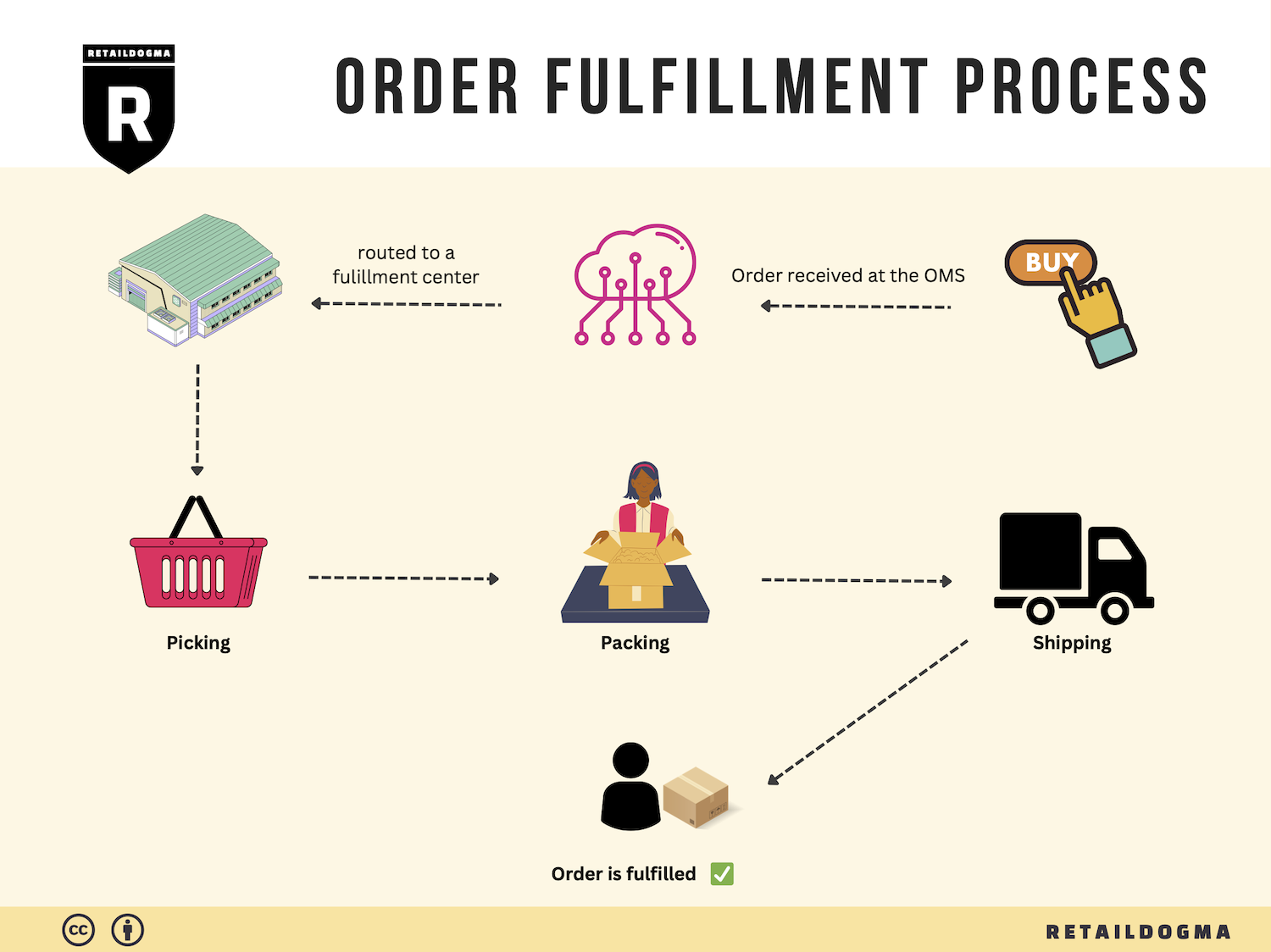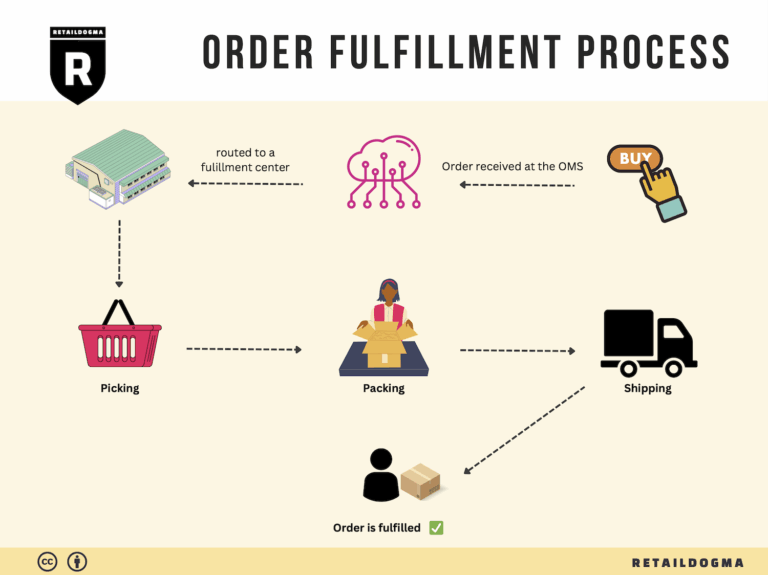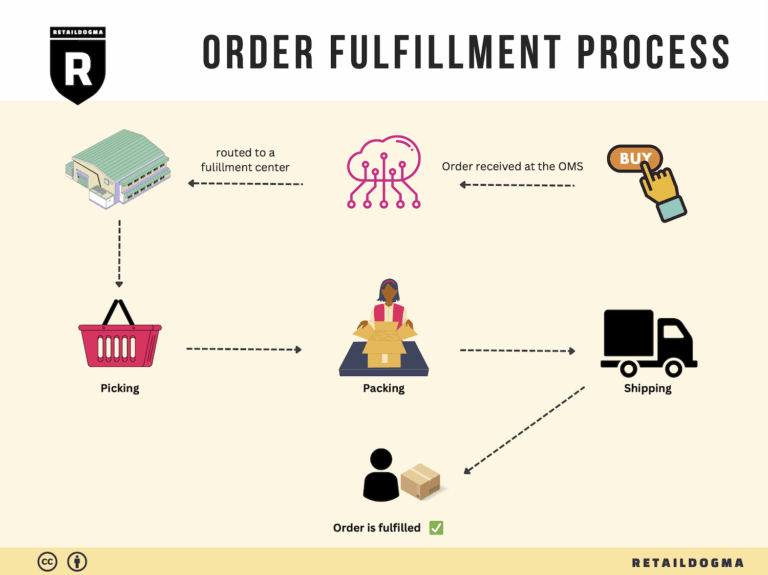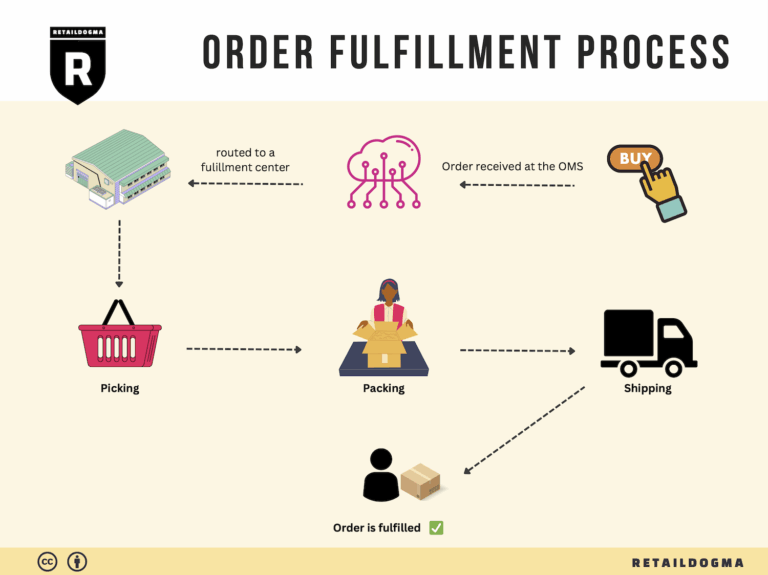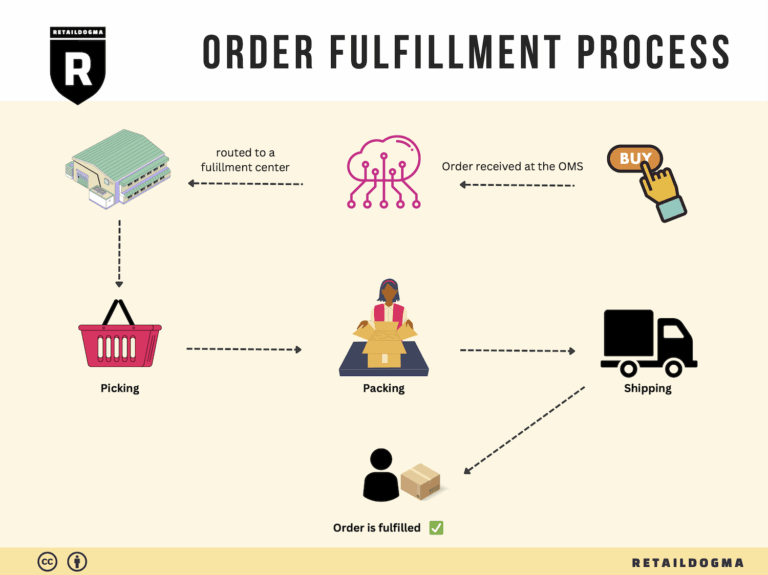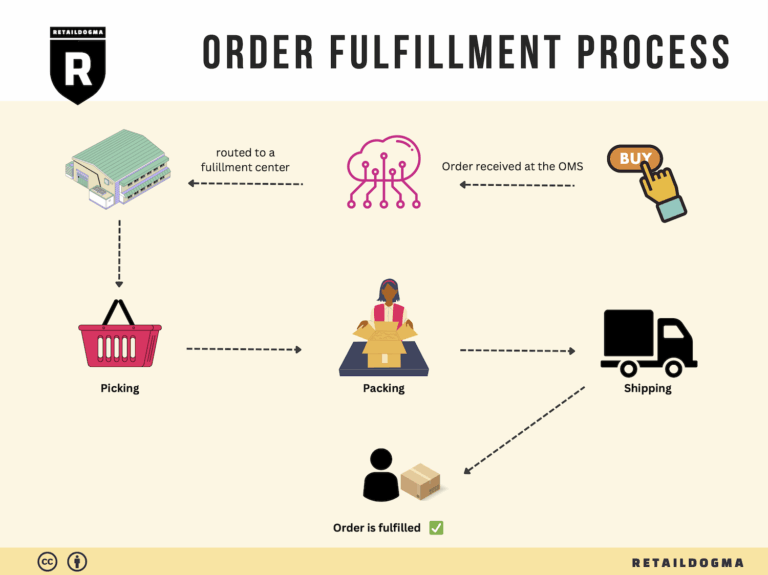How Order Fulfillment Works: A Step-by-Step Guide for Businesses
What is E-commerce Fulfillment? An Introduction for Growing Businesses
Understanding E-commerce Fulfillment
For many growing online businesses, the excitement of expanding sales can quickly turn into a daunting challenge. One common pain point that entrepreneurs face is the overwhelming burden of packing and shipping orders. As sales increase, so do the logistics involved in getting products into the hands of customers. This is where e-commerce fulfillment comes into play, serving as a crucial backbone for successful online operations.
At its core, fulfillment is the process of getting a product from your inventory to your customer’s doorstep. It encompasses everything from receiving and storing products, to picking, packing, and shipping orders, as well as managing returns. With effective fulfillment strategies, businesses can enhance customer satisfaction, streamline operations, and ultimately scale their growth.
This guide aims to demystify the world of e-commerce fulfillment for business owners and operations managers looking to optimize their logistics. We will explore various fulfillment models, including Third-Party Logistics (3PL) and Fulfillment by Amazon (FBA), detailing how each can fit into your business strategy. Understanding these models is essential, as they each offer unique advantages depending on your specific needs.
Moreover, we will delve into the core services that fulfillment partners typically offer, such as inventory management, shipping solutions, and returns processing. Knowing what services are available can help you select a partner that aligns with your business goals and customer expectations.
Choosing the right fulfillment partner can be a game-changer for your operations. This guide will provide insights on how to evaluate potential partners based on factors such as reliability, technology integration, and customer service. We will also discuss pricing structures, helping you understand what to expect in terms of costs and how to find a solution that fits your budget.
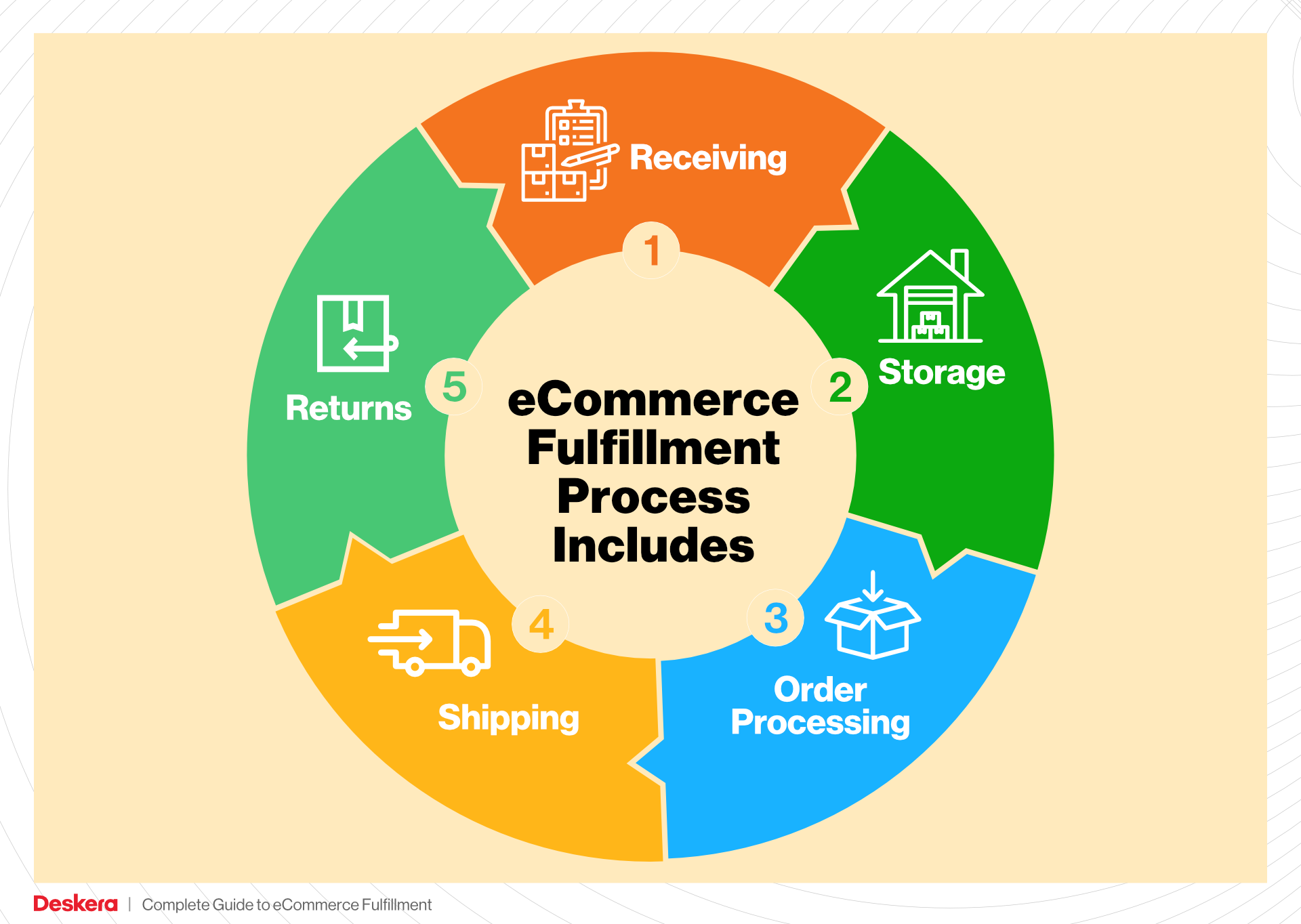
Ultimately, our goal is to empower businesses like yours to make informed decisions about your logistics. By understanding the intricacies of e-commerce fulfillment, you can focus on what you do best—growing your business—while leaving the complexities of order fulfillment to the experts. With the right knowledge and resources, you can transform fulfillment from a burden into a streamlined process that supports your growth.
What You’ll Learn In This Guide
- What is E-commerce Fulfillment? An Introduction for Growing Businesses
- The Order Fulfillment Process: From ‘Buy’ Button to Customer’s Door
- Comparing Fulfillment Models: In-House vs. 3PL vs. Dropshipping
- A Deep Dive into Amazon FBA: Pros, Cons, and Who It’s For
- Core Services Offered by Fulfillment Centers
- How to Choose a Fulfillment Partner: A 6-Point Checklist
- Understanding Fulfillment Pricing: A Breakdown of Common Fees
- Frequently Asked Questions (FAQs) about Fulfillment
- Conclusion: Is Outsourcing Fulfillment the Right Move for Your Business?
- Important Disclaimer
The Order Fulfillment Process: From ‘Buy’ Button to Customer’s Door
1. Receiving Inventory
The order fulfillment process begins with receiving inventory at the fulfillment center. When products arrive, they undergo a thorough product inspection to ensure they meet quality standards and match the purchase order. Each item is assigned a unique SKU (Stock Keeping Unit) for easy tracking and management.
This step is crucial because it sets the foundation for accurate inventory management. By verifying the quantity and condition of the incoming stock, businesses minimize discrepancies that could lead to stockouts or overstock situations later in the process. Proper receiving procedures help ensure that only quality products are available for sale, which directly impacts customer satisfaction and seller ratings on platforms like eBay.
2. Warehouse Storage
Once the inventory is received and inspected, it moves to warehouse storage. In this phase, products are systematically organized in designated areas of the fulfillment center, often using a bin location system. This organization allows for quick retrieval when orders are placed.
Efficient warehouse storage is vital for scaling operations. By optimizing space and ensuring that items are easy to locate, businesses can significantly reduce the time it takes to fulfill orders. Additionally, real-time inventory management systems allow sellers to monitor stock levels, providing insights into when reordering is necessary. This proactive approach helps prevent lost sales due to stockouts and enhances overall operational efficiency.
3. Order Picking
When a customer clicks the ‘Buy’ button on eBay, the next step is order picking. This involves retrieving the purchased items from their storage locations based on a pick list generated by the fulfillment software. The pick list outlines the specific SKUs and quantities needed for each order, allowing the warehouse staff to efficiently gather items.
Order picking is a critical step because it directly affects order accuracy and speed. The faster and more accurately items are picked, the quicker they can be packed and shipped. This impacts customer satisfaction, as timely and correct deliveries are paramount to maintaining high seller ratings on eBay. Implementing technologies such as barcoding or RFID can further enhance picking efficiency and accuracy, reducing human error.
4. Order Packing
After items are picked, they move to the order packing stage. During this process, products are carefully packaged according to the seller’s specifications and branding guidelines. Custom packaging options, such as branded boxes or eco-friendly materials, can also enhance the customer’s unboxing experience.
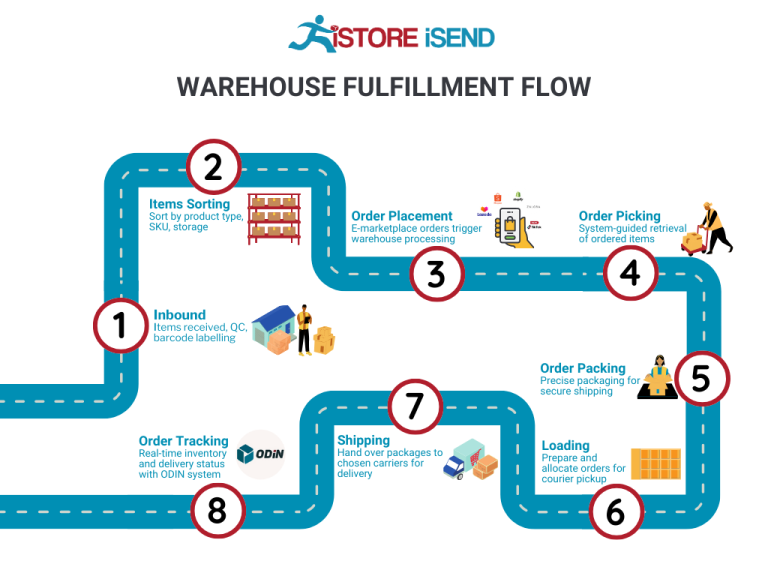
Effective packing is important not only for protecting products during transit but also for branding and customer engagement. A well-packaged order can reinforce the brand identity and encourage repeat purchases. Additionally, ensuring that the packaging complies with shipping standards helps prevent damage during delivery, further enhancing customer satisfaction. It’s essential to consider factors like weight and dimensions when packing, as these influence shipping costs.
5. Shipping & Delivery
The final step in the fulfillment process is shipping and delivery. Once packed, orders are labeled and sent out using various shipping carriers. Fulfillment centers often have partnerships with shipping providers to offer competitive rates and reliable delivery options. Tracking information is generated and shared with customers to keep them informed about their order status.
Efficient shipping is crucial for customer satisfaction. Fast and reliable delivery can significantly enhance a seller’s reputation on eBay, impacting seller ratings positively. Offering multiple shipping options, including expedited services, allows customers to choose what best meets their needs, further improving the shopping experience. Additionally, effective returns processing, which often accompanies shipping, plays a significant role in maintaining customer loyalty. By efficiently managing returns, sellers can keep their inventory fresh and ready for new orders.
In conclusion, the order fulfillment process is a multi-step operation that, when executed effectively, can lead to increased efficiency, improved customer satisfaction, and enhanced seller ratings on eBay. By understanding each step—from receiving inventory to shipping and delivery—business owners can optimize their operations and scale their e-commerce efforts successfully.
Comparing Fulfillment Models: In-House vs. 3PL vs. Dropshipping
Fulfillment Model Comparison
| Model | Who Handles Inventory | Best For (Business Stage) | Key Advantage | Key Disadvantage |
|---|---|---|---|---|
| In-House Fulfillment | Business owner | Startups to Established | Complete control over operations | High overhead costs and labor needs |
| Third-Party Logistics (3PL) | Third-party provider | Growth Stage to Established | Cost-effective and scalable solutions | Less control over fulfillment process |
| Dropshipping | Supplier | Startups to Small Businesses | Low initial investment | Lower profit margins and potential delays |
In-House Fulfillment
In-house fulfillment involves managing the entire logistics process within your own business. This means that you handle everything from inventory storage and order processing to shipping and returns. This model is ideal for startups and established businesses that want complete control over their operations and customer experience. One of the primary advantages of in-house fulfillment is the ability to tailor processes to your specific needs, ensuring that the customer experience aligns with your brand identity. Furthermore, you can quickly adapt to changes in demand or inventory levels without relying on external partners.
However, this model comes with significant disadvantages. Managing fulfillment in-house can lead to high overhead costs, including warehousing expenses, staffing, and equipment investments. As your business grows, these costs can become burdensome, and scaling operations may require additional resources and infrastructure. Moreover, the labor-intensive nature of this model can divert focus from core business activities like marketing and product development.
Third-Party Logistics (3PL)
Third-party logistics (3PL) providers take over the logistics responsibilities from businesses, offering a range of services that include inventory storage, order fulfillment, shipping, and returns management. This model is particularly beneficial for businesses in the growth stage looking to streamline operations without the burden of managing logistics themselves. By outsourcing fulfillment to a 3PL, companies can benefit from cost-effective solutions due to the provider’s established relationships with shipping carriers and their expertise in logistics.
One of the key advantages of using a 3PL is scalability. As your business grows, a 3PL can easily adjust to increased order volumes without requiring you to invest in additional infrastructure. Additionally, 3PLs often utilize advanced technology for inventory management and order tracking, providing you with real-time insights into your operations. However, the trade-off is that you may have less control over the fulfillment process. Issues such as shipping delays or inventory inaccuracies can impact your customer experience, and communicating these challenges with your 3PL can sometimes lead to friction.
Dropshipping
Dropshipping is a fulfillment model where the retailer does not hold inventory but instead transfers customer orders directly to a supplier, who then ships the products on behalf of the retailer. This model is ideal for startups or small businesses that want to minimize upfront investment and operational complexity. With dropshipping, you can offer a wide range of products without the financial risk associated with purchasing inventory upfront.
The primary advantage of dropshipping is the low initial investment required to start selling. Since you don’t need to invest in inventory or warehousing, you can focus on marketing and customer acquisition. Additionally, dropshipping allows for flexibility in product offerings, enabling you to quickly adapt to market trends without the risk of unsold inventory. However, dropshipping also comes with significant disadvantages, including lower profit margins due to the reliance on third-party suppliers and potential delays in shipping and order fulfillment. Moreover, since you do not control the inventory or shipping processes, the customer experience can suffer if suppliers fail to meet quality or delivery expectations.

Conclusion
Choosing the right fulfillment model is critical for the success of your e-commerce business. Each model—In-house fulfillment, 3PL, and dropshipping—offers distinct advantages and disadvantages that align with different business stages and operational goals. By carefully evaluating your specific needs, budget, and growth plans, you can select a fulfillment strategy that not only meets your current requirements but also supports your long-term scalability and customer satisfaction objectives. Whether you opt for in-house management to maintain control, partner with a 3PL for efficiency, or adopt dropshipping for flexibility, understanding these models will empower you to make informed decisions as you navigate the complexities of e-commerce logistics.
A Deep Dive into Amazon FBA: Pros, Cons, and Who It’s For
Understanding Fulfillment by Amazon (FBA)
Fulfillment by Amazon (FBA) is a service provided by Amazon that allows sellers to store their products in Amazon’s fulfillment centers. Amazon then takes care of storage, packaging, shipping, and customer service for these products. This service has become increasingly popular among e-commerce business owners looking to leverage Amazon’s vast logistics network and customer base to enhance their sales and streamline their operations.
How FBA Works
When a seller enrolls in FBA, they send their inventory to Amazon’s warehouses. Once the products are stored, sellers can list their items for sale on Amazon’s platform. When a customer places an order, Amazon picks, packs, and ships the product directly to the customer. Additionally, Amazon handles customer inquiries and returns, making it a comprehensive solution for sellers.
Sellers benefit from Amazon’s Prime membership program, which offers fast shipping options to Prime members, thereby increasing the likelihood of sales. The FBA system also integrates seamlessly with other e-commerce platforms, allowing sellers to manage orders from multiple channels through Amazon’s interface.
Pros of Using FBA
-
Prime Eligibility: One of the most significant advantages of FBA is that products become eligible for Amazon Prime. This means that items can be shipped with the speed and reliability that Prime members expect, often resulting in higher sales and customer satisfaction.
-
Customer Trust: Amazon is a well-established brand with a reputation for excellent customer service. When sellers use FBA, their products are backed by Amazon’s return policies and customer support, which can enhance buyer trust and encourage purchases.
-
Multi-Channel Fulfillment: FBA is not limited to just Amazon sales. Sellers can use FBA to fulfill orders from their own websites or other marketplaces, making it a versatile option for those who want to diversify their sales channels without managing multiple fulfillment solutions.
-
Time Savings: By outsourcing logistics to Amazon, sellers can focus more on growing their business, such as product sourcing, marketing, and customer engagement, rather than the day-to-day operations of order fulfillment.
-
Scalability: FBA allows businesses to scale quickly. As demand grows, sellers can send more inventory to Amazon without needing to invest in their own warehousing or logistics infrastructure.
-
Advanced Logistics: Amazon’s logistics network is one of the most advanced in the world. Sellers benefit from faster shipping times and the ability to reach customers across the globe, which can be particularly advantageous for businesses looking to expand their market reach.
Cons of Using FBA
-
High Fees: While FBA offers numerous benefits, it also comes with costs that can add up quickly. Sellers incur storage fees for keeping inventory in Amazon’s warehouses, as well as fulfillment fees for each order processed. For some sellers, these fees can significantly eat into profit margins.
-
Strict Inventory Rules: Amazon has stringent guidelines regarding inventory management, including requirements for product packaging and labeling. Non-compliance can lead to additional fees or the rejection of inventory, which can be frustrating for sellers.
-
Commingling Risks: FBA uses a system called commingling, where inventory from different sellers may be stored together. This can lead to issues if a seller’s product is mixed with inferior quality products, potentially affecting seller ratings and customer satisfaction.
-
Limited Control Over Shipping: While Amazon manages shipping, sellers have limited control over the logistics process. This lack of control can be challenging, especially if there are delays or issues with shipping that impact customer satisfaction.
-
Return Management: Amazon’s return policies are favorable for customers, but they can be less so for sellers. Returns are processed through Amazon, which may not always align with a seller’s preferences regarding how returned items are handled.
Who is FBA Best For?
Fulfillment by Amazon is ideal for a variety of sellers, particularly those who are looking to scale their operations without the burden of logistics management. Here are some categories of sellers who may benefit most from FBA:
-
Small to Medium-Sized Businesses: For businesses that are growing but do not yet have the resources to manage their logistics, FBA provides a scalable solution that allows them to focus on other aspects of their business.
-
Sellers with High Sales Volume: Those who experience high demand for their products can leverage FBA to ensure that they can meet customer expectations for fast shipping and reliable service.
-
Brands Looking to Build Trust: Sellers who are new to e-commerce or do not have an established brand may find that using FBA helps them build customer trust more quickly due to Amazon’s reputation.
-
Multi-Channel Sellers: Businesses that sell across multiple platforms can benefit from FBA’s multi-channel fulfillment options, allowing them to streamline their operations while reaching a broader audience.
In conclusion, while Fulfillment by Amazon offers numerous advantages in terms of reach, efficiency, and customer service, it’s essential for sellers to weigh these benefits against the potential downsides, such as fees and control over inventory. By understanding their business needs and customer expectations, sellers can make informed decisions about whether FBA is the right fit for them.
Core Services Offered by Fulfillment Centers
Inventory Management & Warehousing
Effective inventory management and warehousing are crucial components of any e-commerce operation, especially for businesses scaling on platforms like eBay. Fulfillment centers provide dedicated storage space for your products, ensuring they are organized and easily accessible.
With advanced inventory management systems, fulfillment centers can track stock levels in real-time, helping you maintain optimal inventory without overstocking or stockouts. This capability is particularly beneficial for e-commerce businesses, as it allows for better forecasting and demand planning. By utilizing a fulfillment center, you gain access to sophisticated software that integrates with your e-commerce platform, providing insights into inventory turnover rates, seasonal trends, and sales performance.
The benefits of this service include reduced overhead costs associated with maintaining your own warehouse, improved cash flow through better inventory management, and the ability to scale operations without the logistical burdens of managing storage space. By outsourcing warehousing to a fulfillment partner, you can focus on other critical areas of your business, such as marketing and customer service, while ensuring that your inventory is managed efficiently.
Pick and Pack Services
Pick and pack services are a cornerstone of fulfillment operations. This process involves selecting items from inventory (picking) and preparing them for shipment (packing) according to specific order requirements. Fulfillment centers employ streamlined procedures to ensure that orders are processed quickly and accurately.
Using a fulfillment center for pick and pack services allows your business to benefit from faster order processing times. Many centers utilize technology such as barcode scanning and automated picking systems to minimize errors and enhance speed. This efficiency translates to improved customer satisfaction, as orders are shipped promptly and accurately.
Additionally, fulfillment centers can customize the packing process to align with your brand’s identity. This includes using branded packaging, personalized messages, or specific packing materials that enhance the unboxing experience for customers. Such attention to detail can lead to increased customer loyalty and repeat purchases, vital for long-term business growth.
Kitting and Assembly
Kitting and assembly services enable e-commerce businesses to offer bundled products or complex items that require assembly before shipping. This service is particularly advantageous for sellers of multi-component products, such as electronics, DIY kits, or promotional bundles.
Fulfillment centers can efficiently assemble these kits according to your specifications, ensuring that all components are included and correctly packaged. This service not only saves you time and labor costs but also enhances the overall customer experience. Customers appreciate receiving ready-to-use products without the hassle of assembly, which can be a significant selling point.
Moreover, kitting can help boost your average order value (AOV) by promoting bundled products at a discounted rate, encouraging customers to purchase more items together. This strategy can lead to higher sales and a more efficient inventory turnover, as slower-moving items can be paired with popular products.
Returns Management (Reverse Logistics)
Returns management, or reverse logistics, is a critical service provided by fulfillment centers that can significantly impact your e-commerce business’s profitability and customer satisfaction. Effective returns management involves the process of handling returned items, restocking them, and managing any necessary repairs or refurbishments.
A fulfillment center streamlines this process by providing a structured approach to returns. When a customer initiates a return, the fulfillment center can quickly assess the condition of the returned item, determine whether it can be restocked or needs to be repaired, and manage the logistics of returning the item to inventory. This efficiency not only saves you time but also ensures that your inventory levels are accurate and up to date.
Additionally, handling returns through a fulfillment center can enhance your customer service. A well-managed returns process can improve customer satisfaction, as buyers appreciate hassle-free returns. This positive experience can lead to better seller ratings on eBay, which can significantly impact your business’s reputation and sales performance.
In summary, effective returns management is essential for maintaining customer trust and loyalty, as well as for optimizing your operational efficiency. By outsourcing this function to a fulfillment partner, you can focus on growth strategies while ensuring that your returns process is handled professionally and efficiently.
In conclusion, leveraging the core services offered by fulfillment centers can provide e-commerce businesses with the infrastructure necessary to scale effectively. From inventory management and pick-and-pack services to kitting and returns management, these services allow you to focus on what you do best—growing your business and serving your customers.
How to Choose a Fulfillment Partner: A 6-Point Checklist
Location & Warehouse Network
Importance:
The geographical location of your fulfillment partner’s warehouses is critical for several reasons. Proximity to your customer base can significantly reduce shipping times and costs, ultimately enhancing customer satisfaction. Additionally, a broad warehouse network can facilitate faster order processing and distribution.
Questions to Ask:
– Where are your warehouses located, and how do they align with my target market?
– Can you provide shipping estimates based on your warehouse locations?
– Do you have multiple fulfillment centers, and how do you manage inventory across these locations?
Technology & Integrations
Importance:
In today’s fast-paced e-commerce landscape, technology plays a pivotal role in streamlining operations. A fulfillment partner should offer robust technology solutions that integrate seamlessly with your existing e-commerce platforms. This can enhance order tracking, inventory management, and overall operational efficiency.
Questions to Ask:
– What technology do you use for order management, and how does it integrate with eBay and other platforms?
– Do you offer real-time inventory tracking and reporting?
– How frequently do you update your technology and software systems?
Specializations (e.g., Cold Storage, Oversized Items)
Importance:
Different products require different handling and storage solutions. If you sell specialized items, such as perishables or oversized products, it’s essential to partner with a fulfillment center that has the expertise and facilities to accommodate these needs.
Questions to Ask:
– Do you have specific capabilities for handling specialized items, such as cold storage or oversized products?
– Can you provide examples of how you’ve successfully managed similar products for other clients?
– What precautions do you take to ensure the integrity of specialized items during storage and shipping?
Scalability & Capacity
Importance:
As your business grows, your fulfillment needs will change. It’s crucial to select a partner who can scale operations to meet increasing demand without compromising service quality. A scalable partner can accommodate seasonal spikes in orders or unexpected surges in sales.
Questions to Ask:
– How do you handle fluctuations in order volume, such as during peak seasons?
– What is your maximum capacity for order fulfillment, and how quickly can you scale up?
– Can you provide references from businesses similar to mine that have successfully scaled with your services?
Pricing and Contracts
Importance:
Understanding the pricing structure and contract terms is essential for budgeting and financial planning. You want a partner whose pricing is transparent and competitive, with no hidden fees. Additionally, flexible contract terms can provide peace of mind as your business evolves.
Questions to Ask:
– What is your pricing model (e.g., per order, per item, monthly fees), and what factors can affect pricing?
– Are there any additional fees for services such as returns processing or custom packaging?
– What are the terms of the contract, and is there flexibility for renegotiation as my business grows?
Customer Support & Reviews
Importance:
Exceptional customer service is a hallmark of a reliable fulfillment partner. You want a partner who is responsive and proactive in addressing issues that may arise. Furthermore, customer reviews and testimonials can provide insights into the experiences of other businesses.
Questions to Ask:
– What levels of customer support do you offer (e.g., dedicated account managers, 24/7 support)?
– Can you share testimonials or case studies from clients in my industry?
– How do you handle disputes or issues with order fulfillment, and what is the typical response time?
Conclusion
Choosing the right fulfillment partner is a critical decision that can influence the success of your e-commerce business on platforms like eBay. By carefully evaluating potential partners through this checklist, you can ensure that you select a provider that aligns with your operational needs and growth ambitions. Prioritize these factors to make a well-informed decision that supports your business objectives and enhances customer satisfaction.
Understanding Fulfillment Pricing: A Breakdown of Common Fees
Initial Setup Fees
Initial setup fees are one-time costs incurred when you start using a fulfillment service. These fees can vary widely among providers and may cover the cost of onboarding your business, integrating with your eBay store, and configuring any necessary technology. Some fulfillment centers, like eFulfillment Service, do not charge any setup fees, which can be a significant advantage for small businesses or those just starting out. It’s crucial to ask potential providers about any hidden fees associated with setup, as these can impact your overall budget.
Receiving Fees
Receiving fees are charged when your inventory arrives at the fulfillment center. These fees generally cover the costs of unloading, inspecting, and storing your products. The calculation of receiving fees can depend on various factors, including the volume of inventory being received and the complexity of handling (e.g., inspecting fragile items). Some fulfillment centers may charge a flat fee per shipment, while others might charge based on the number of pallets or items received. It’s advisable to inquire about these fees upfront to budget accordingly.
Storage Fees (per pallet/bin)
Storage fees are ongoing costs associated with keeping your inventory at the fulfillment center. These fees are typically calculated based on the amount of space your products occupy, measured in pallets or bins. Most fulfillment centers charge monthly storage fees, and the rates can vary based on the location of the warehouse, the type of products stored, and the duration of storage. For instance, seasonal fluctuations may require you to store more inventory at certain times of the year, leading to increased storage costs. Be sure to understand how long your products will be stored and the fees associated with longer storage times, as these can accumulate quickly.
Pick & Pack Fees (per item/order)
Pick and pack fees are charged for the labor involved in retrieving items from storage and preparing them for shipment. This fee is typically calculated on a per-item or per-order basis. For example, if a customer orders multiple items, the pick and pack fee may be multiplied by the number of items picked. Some fulfillment centers offer tiered pricing based on order volume, meaning that as your order volume increases, your per-item costs may decrease. It’s essential to analyze your sales patterns to determine how pick and pack fees will impact your overall fulfillment costs.
Shipping Fees
Shipping fees are among the most significant costs associated with order fulfillment. These fees depend on various factors, including the shipping method selected, the weight and dimensions of the package, the destination, and the shipping carrier used. Most fulfillment centers negotiate shipping rates with carriers, which can lead to lower costs for you compared to what you might secure independently. It’s advisable to compare the shipping options provided by different fulfillment centers and consider their delivery times and reliability, as these factors can also impact your customer satisfaction and seller ratings on eBay.
Tips for Getting an Accurate Quote
To get an accurate quote from fulfillment providers, follow these practical steps:
-
Provide Detailed Information: When reaching out for quotes, share comprehensive details about your business, including the types of products you sell, average order sizes, and expected order volumes. This will help providers give you a more tailored estimate.
-
Ask About All Fees: Ensure that you inquire about all potential fees, including those that may not be immediately obvious, such as account maintenance or customer service fees.
-
Compare Multiple Providers: Don’t settle for the first quote you receive. Comparing multiple fulfillment centers can provide insights into the standard pricing within the industry and help you identify the best overall value.
-
Consider Long-Term Costs: Look beyond initial setup fees and consider how ongoing costs like storage, pick and pack, and shipping fees will affect your budget over time.
-
Negotiate Terms: Many fulfillment centers are open to negotiation, especially if you expect to have a high volume of orders. Don’t hesitate to discuss terms that could lead to reduced fees or better service levels.
By understanding these common fees and how they are calculated, you can make more informed decisions as you scale your eBay business and choose the right fulfillment partner.
Frequently Asked Questions (FAQs) about Fulfillment
1. What is eBay Fulfillment?
eBay Fulfillment refers to the process of managing and delivering products sold on eBay through third-party logistics (3PL) providers. These providers handle various aspects of order fulfillment, including inventory storage, order picking and packing, shipping, and returns management, allowing sellers to focus on growing their business.
2. What is a fulfillment center?
A fulfillment center is a specialized warehouse where products are stored, processed, and shipped to customers. Unlike traditional warehouses that primarily focus on storage, fulfillment centers emphasize order processing and shipping efficiency, ensuring quick delivery times and streamlined operations for e-commerce businesses.
3. What’s the difference between a warehouse and a fulfillment center?
The primary difference lies in their functions: a warehouse is primarily for storage, while a fulfillment center focuses on the entire order fulfillment process, including inventory management, order processing, packaging, and shipping. Fulfillment centers are designed to handle high-volume order processing and provide faster shipping options.
4. What is a 3PL (Third-Party Logistics)?
A 3PL is a service provider that manages logistics and supply chain operations for businesses. This includes warehousing, transportation, order fulfillment, and returns management. By outsourcing these functions to a 3PL, businesses can reduce overhead costs, improve efficiency, and focus on core activities like marketing and sales.
5. How do I choose the right fulfillment partner for my eBay business?
When selecting a fulfillment partner, consider factors such as their experience with eBay sellers, service offerings, technology integration capabilities, shipping options, pricing structure, and customer service reputation. It’s essential to choose a partner that aligns with your business goals and can scale with your growth.
6. How much do fulfillment services cost?
Fulfillment service costs can vary widely based on factors such as storage fees, order processing fees, shipping costs, and any additional services like custom packaging or returns management. Generally, providers offer flexible pricing models, including pay-as-you-go options, which allow businesses to manage costs effectively based on their order volume.
7. What are the benefits of using eBay fulfillment services?
Using eBay fulfillment services can lead to lower operational costs, improved seller ratings, faster shipping times, and enhanced customer satisfaction. These services allow sellers to streamline their logistics, manage inventory more efficiently, and focus on scaling their business without the burden of handling logistics in-house.
8. How does inventory management work in eBay fulfillment?
Most fulfillment centers offer real-time inventory management systems that integrate with your eBay store. This allows you to monitor stock levels, receive alerts for low inventory, and manage your orders efficiently. Accurate inventory management is crucial to prevent stockouts and ensure timely order fulfillment.
9. Can I use a fulfillment center for multiple sales channels?
Yes, many fulfillment centers support multi-channel fulfillment, allowing you to manage orders from various platforms (like eBay, Amazon, and your own website) through a single system. This integration simplifies operations, reduces errors, and provides a cohesive view of your inventory and sales across channels.
10. How does returns processing work with eBay fulfillment?
Fulfillment centers typically handle returns management by inspecting returned items, updating inventory records, and determining the best course of action for returned products. This can include restocking items, refurbishing them, or managing customer refunds, which helps streamline the returns process and maintain customer satisfaction.
Conclusion: Is Outsourcing Fulfillment the Right Move for Your Business?
The Strategic Advantage of Outsourcing Fulfillment
As e-commerce continues to evolve, the decision to outsource fulfillment can significantly impact your business’s scalability and efficiency. Utilizing a fulfillment service offers several key benefits that can streamline your operations and enhance your customer experience.
Firstly, outsourcing fulfillment saves valuable time. By delegating tasks such as inventory management, order processing, and shipping to a specialized partner, you can focus on core business activities like marketing and product development. This shift allows you to allocate your resources more effectively, ultimately driving growth.
Secondly, scalability is a crucial advantage of working with a fulfillment partner. As your business grows, so do your logistics needs. A proficient third-party logistics (3PL) provider can adapt to your evolving requirements, whether you’re expanding product lines, entering new markets, or experiencing seasonal fluctuations in demand. This flexibility ensures that your operations remain efficient, regardless of changes in volume.
Moreover, partnering with an experienced fulfillment service grants you access to industry expertise. These providers have honed their logistics processes, leveraging technology and best practices to optimize efficiency and reduce costs. Their knowledge can lead to improved shipping rates and faster delivery times, which are essential for maintaining high seller ratings on platforms like eBay.
However, it is vital to choose the right fulfillment partner to support your growth trajectory. Look for a provider that aligns with your business goals, offers transparent pricing, and demonstrates a commitment to customer service.
Call to Action
Take the first step toward enhancing your logistics strategy by auditing your current shipping processes. Assess whether the time and resources spent on fulfillment could be better utilized elsewhere in your business. If you find inefficiencies or limitations, consider reaching out to a fulfillment partner to explore how they can help you scale effectively and meet your customers’ expectations.
Important Disclaimer
⚠️ Important Disclaimer
The information in this guide is for educational purposes. Fulfillment services, pricing, and platform features change frequently. Always conduct your own due diligence and consult with providers directly before making business decisions.
